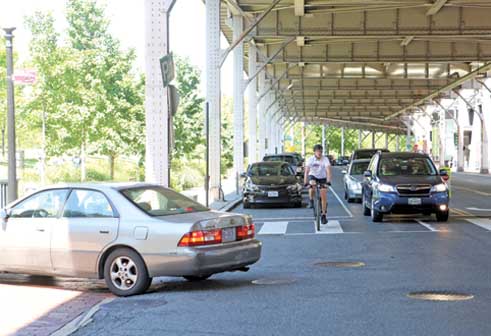Waterfront Eyed for Bike Upgrades

By Mark LiebermanCurrent Staff Writer
The roadway and sidewalks adjacent to the Georgetown Waterfront Park are slated for various safety, accessibility and aesthetic upgrades over the next few years, according to plans presented by the Georgetown Business Improvement District at a walkthrough event Saturday.
The business group has been working for the last six months with the D.C. Department of Transportation and Toole Design Group, using a $60,000 grant from the Metropolitan Washington Council of Governments, to develop plans for improved infrastructure for pedestrians, cyclists and motorists along K and Water streets NW. The project aims to connect the Capital Crescent Trail west of the park with the Rock Creek Trail to the east, resolving what the BID’s Joe Sternlieb calls a “very awkward interface” between the two.
The first of two phases will add a dedicated bike lane from the end of the Capital Crescent Trail down Water Street, improve crosswalks along Water and K streets, and establish an aesthetically appealing trailhead at the western end of Water within the next year. (Water Street is an alternate name for the section of K Street west of 33rd Street NW.) Plans for this “interim” phase also call for a traffic circle turnaround at the intersection of Water and 34th streets NW, in order to indicate to motorists traveling west on Water Street that there’s no outlet farther down that stretch.
Sternlieb estimates that costs for the interim stage could exceed $100,000, but he declined to provide a specific figure until the designs are closer to completion.
The second, “optimum” phase will launch sometime after the District extends a planned streetcar line to Georgetown — which won’t happen for several more years at least. Much of the roadway on K and Water streets NW will be taken up by the streetcar, forcing the bike trail’s move to an expanded pathway in the waterfront park. This phase also enhances the turnaround.
Street parking on Water near the Capital Crescent Trail is most likely to be affected by the plans, but the exact number of spots that will be removed is still in flux, Georgetown BID transportation director Will Handsfield said. Options such as garage parking to replace the affected street parking are being explored, he said.
The existing bike path from the Capital Crescent Trail sends cyclists onto the narrow sidewalk that runs between the park and the roadway. Handsfield said most cyclists avoid that sidewalk altogether, and a dedicated lane on the road will streamline the confusion that riders often face when they exit the trail and arrive in Georgetown.
On the Rock Creek side of the park, the interim phase includes expanded sidewalks at the trail entrance, and the optimum phase includes a pedestrian and bicycle bridge that would hang from the eastbound Whitehurst Freeway off-ramp to southbound I-66 and connect users coming from K Street to the Rock Creek Trail.
Handsfield said motorists traveling on K and Water streets are not required to stop at any point west of Wisconsin Avenue. Bulb-out additions to the sidewalks at intersections will reduce the amount of time pedestrians spend in the street and make them more visible to drivers, he said.
Meanwhile, the turnaround will prevent drivers from clogging the area near the Capital Crescent trailhead, he said. And the handful of attendees at Saturday’s walkthrough saw firsthand that the sidewalks on the southern side of K Street, with periodic poles blocking parts of the way, can be cumbersome to navigate.
Most stakeholders at Saturday’s event agreed that the street under the Whitehurst Freeway needs improvement. “It does seem like this area’s been kind of forgotten,” a resident said during the tour.
But not everyone agrees on the best approach for the area, which involves balancing competing interests among motorists, bicyclists and pedestrians. One nearby resident said Saturday that she thinks sidewalks should be a higher priority than parking spaces. Yet all of the current available parking spaces along Water Street were taken during Saturday’s walkthrough, indicating that they’re in high demand.
Georgetown advisory neighborhood commissioner Bill Starrels attended Saturday’s walkthrough and said he liked the plans. But he thinks the funding might be better utilized addressing immediate issues rather than scheduling a project that could be delayed for years if the streetcar takes longer than expected.
In particular, he suggests widening the westbound lanes of K Street between 27th and 29th streets NW and adding more “dramatic lighting” to reduce safety concerns below the Whitehurst. He also thinks reducing available street parking could cause negative impacts.
“We have to, at least, get DDOT to take a step back and make sure that all interests are being weighed more or less evenly when they’re looking at these larger ideas,” Starrels said.
Meanwhile, Erik Meyers of the Potomac Boat Club told The Current at the walkthrough that his group has concerns about losing dedicated parking spaces near the Capital Crescent Trail, as well as the prospect of bringing a high volume of tourists to the improved trailhead. He plans to suggest amendments to the optimum plan as it progresses. “It’s all compromise,” he said.
This article appears in the June 29 issue of The Georgetown Current newspaper.
